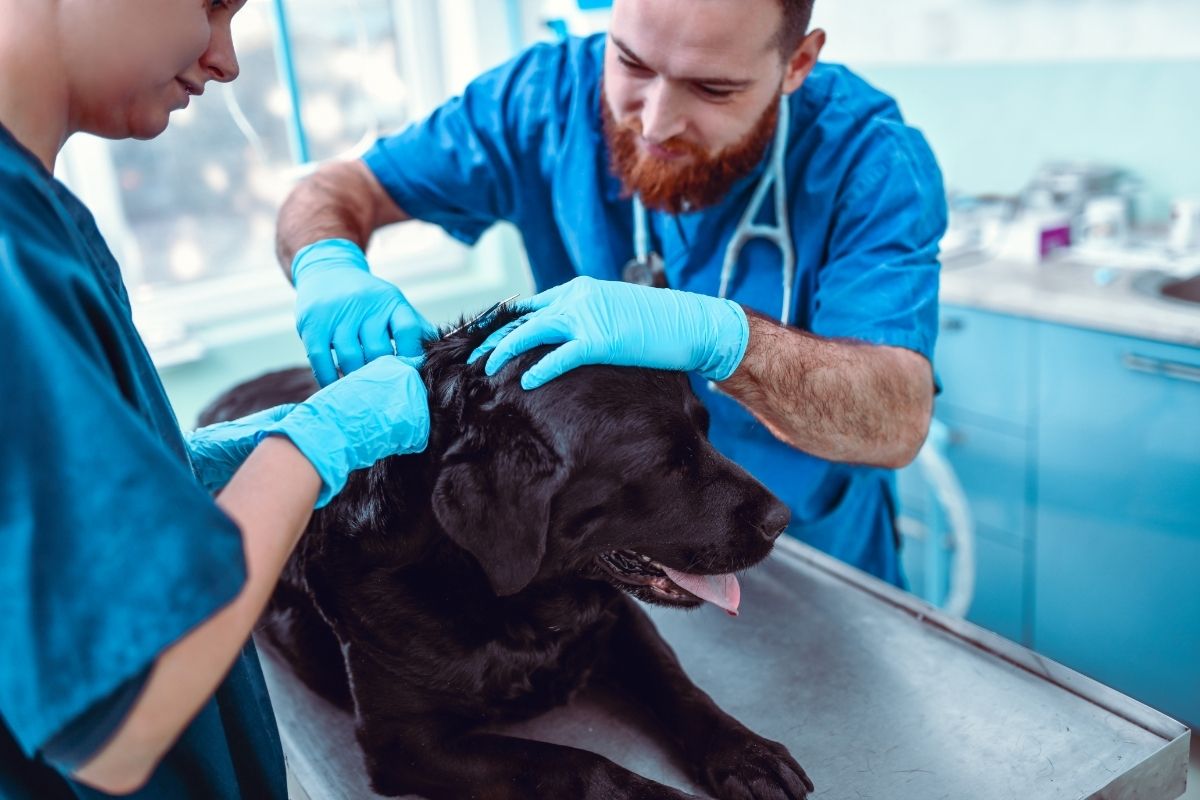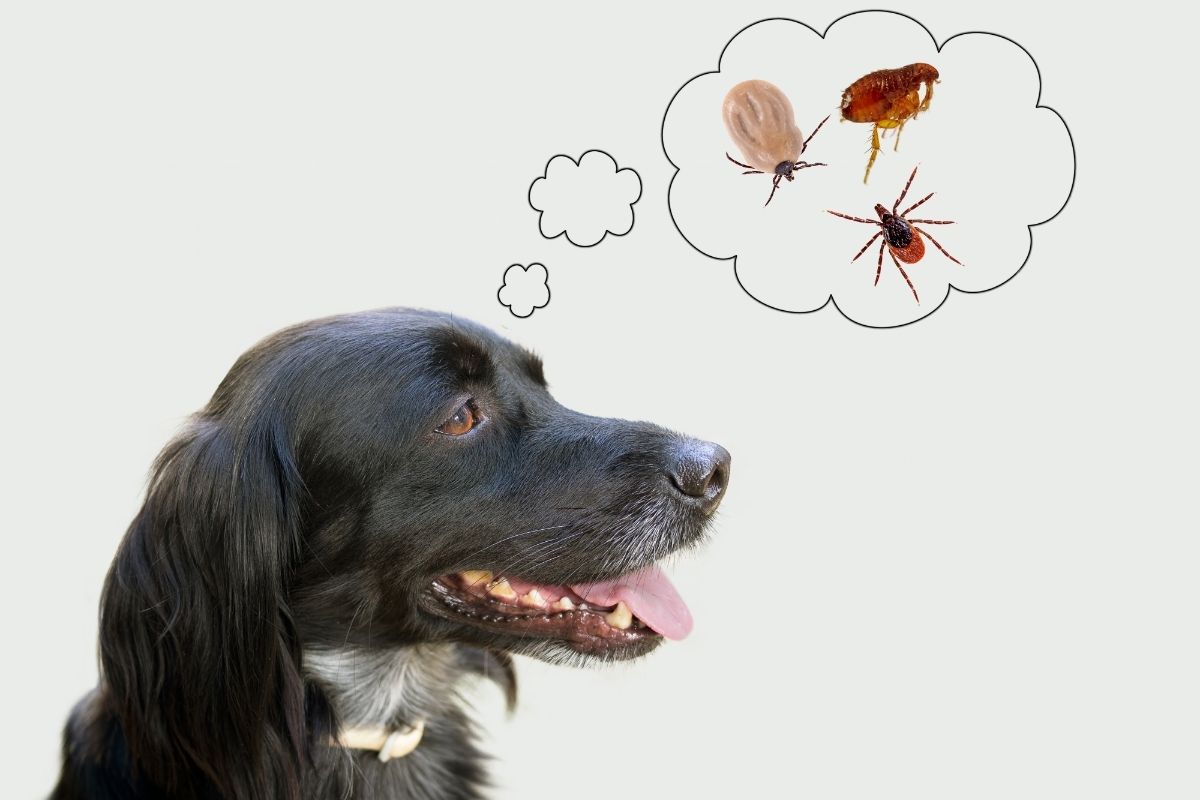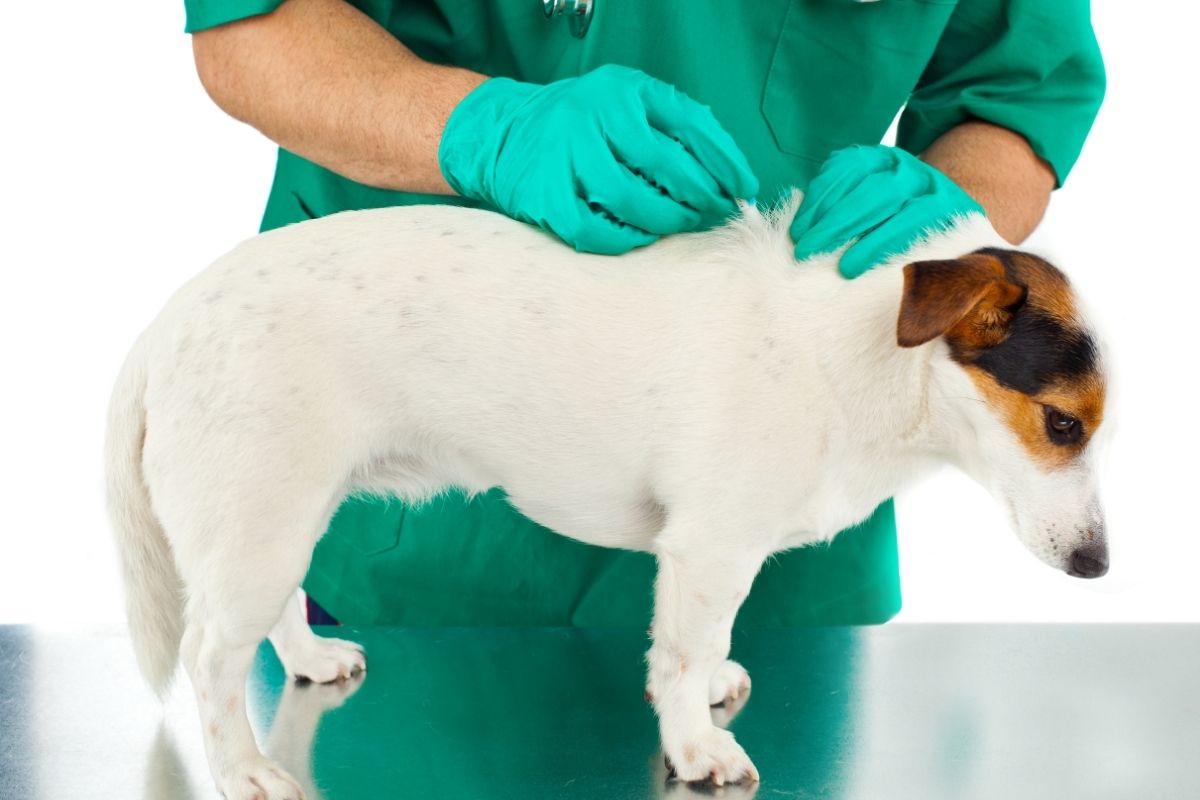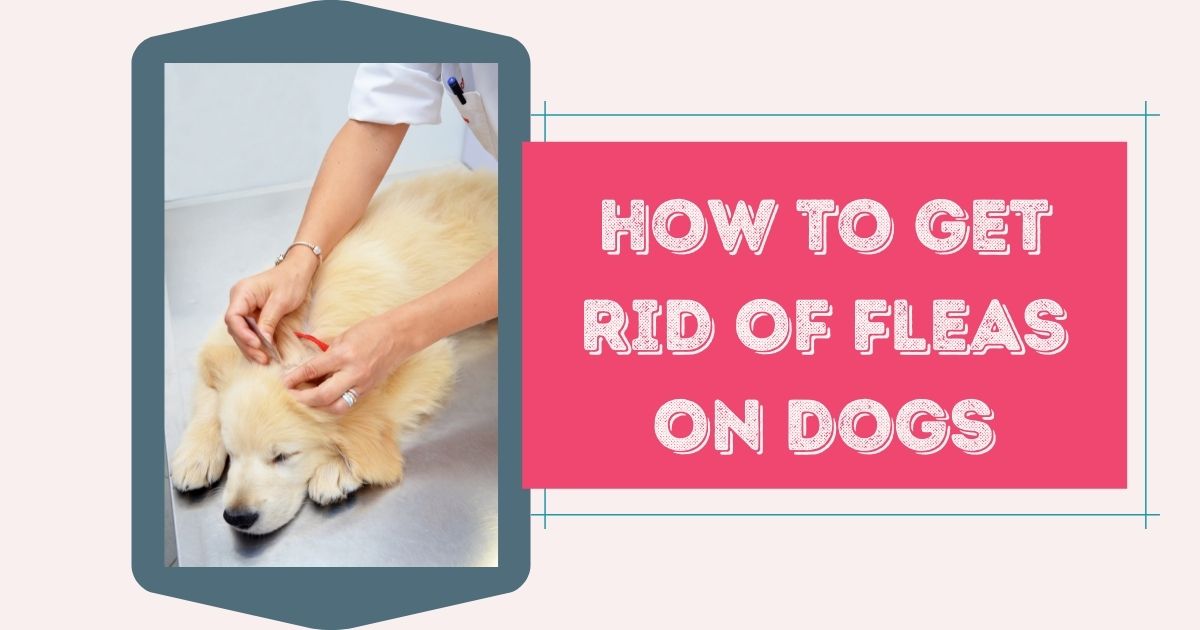How to get rid of fleas on dogs?
You may be asking how do dogs get fleas in the first place. Well, fleas are tiny insects that live on animals and feed off their blood. They can jump from one animal to another if they’re close enough together.
Dogs are more likely to have fleas because they spend a lot of time outdoors where there are lots of other animals around.
If they spend time outdoors in the yard or in areas where wild animals live, fleas can jump onto them quite easily. Likewise, if your dog is near other animals like cats, mice, birds, squirrels, and rabbits, fleas will be able to find their way to your pet (and vice versa).
There are many ways you can get rid of these pesky pests! Whether it’s medicine for fleas in dogs to spot-on solutions, you’re sure to find something that will help.
Let’s explore some of the best ways to eliminate fleas on dogs.

How Do Dogs Get Fleas?
Dogs can get fleas in a variety of ways. Here are some of the most common ways your dog can get fleas.
Other Animals Outdoors
If your dog spends a lot of time around other wild or domesticated animals, they’re more likely to pick up fleas. In addition, fleas can jump from one animal to another, so if your dog is near a group of animals, fleas will definitely find their way to it.
Some of the most common animals to have fleas are rabbits, mice, birds, cats, and even squirrels. If your dog is on a hike or outside playing in a park, they could come into contact with these animals and pick up some unwanted hitchhikers.
In the Yard
If you have a backyard for your dog, they’re more likely to pick up fleas there. There may be wild animals around the yard, and if your dog spends a lot of time outside, they can catch them without knowing it.
If the grass is long, that’s a place where fleas like to live and wait for their next meal. Unfortunately, it’s also possible that you don’t know you have fleas in your outdoor space until your pet comes into contact with them.
A New Animal In the House
Your dog could also get fleas if a new animal, like a cat, for example, comes into your house and brings them along with it. Even if that new animal doesn’t have fleas at the time, your pet could also get them if it’s been in contact with another animal that has them.
In some cases, your dog could get fleas from a new animal already living in the house. Even though they may have never had contact with another animal with fleas before, they can pick up a few while roughhousing.
Your Home
As if you didn’t already have enough problems to deal with, your home could be infested with fleas, and you don’t even know it yet. There may be a few stray fleas on the carpet or the furniture, and they will eventually end up on your dog’s fur.
Fleas can spread into your home in several different ways. For example, they could be brought inside by other pets in the house or even wild animals that have come into contact with them.
Fleas can also come into your home through infested bedding, clothes, or furniture that have been brought inside. If you have fleas in the house already, they will most likely get on your dog’s fur.
Dogs Can Get Fleas From You!
Yes, even you could give your dog fleas. Sometimes when you pet or cuddle with your pup, they can pick up a few fleas from your clothes or hair.
So if you like to be affectionate with your pet and often share hugs and kisses with them, know that they can get fleas this way.
What Are Fleas on Dogs?
Fleas are tiny insects that can be of many colors depending on the species. For example, some fleas are black, brown, or reddish-brown, while others may have white or gray stripes running vertically along with their bodies.
If you look closely, you may find adult fleas are about the size of an apple seed, but you can spot them easier with a flea comb. This is because their bodies are flat, allowing them to easily move between hairs and fur.
They have six legs that they use for jumping long distances from host to host or just to get on top of their food source (your dog).
They have strong mouthparts used to pierce the skin and suck up blood. The saliva they leave behind can irritate your dog’s skin, which causes them to scratch and itch.
They tend to be most active at night because this is when their food source will be sleeping or resting on surfaces they can jump onto.
You can find flea bites on dogs anywhere on the body, but you will often see them on the lower part of a dog’s legs and around their stomach/belly area. The irritated skin from the saliva can leave behind red bumps and rashes, as well as severe itching.

How to Get Rid of Fleas on Dogs
There are many ways you can get rid of your dog fleas, so you must do your research before deciding what method will be best for your pet.
If you have a heavy flea infestation, it’s best to consult with your vet before going out and buying the first thing you find. They may recommend one treatment over another and advise how often you should apply it.
Here are some of the best flea treatment options for your dog:
Vacuuming
This may seem like an obvious way to eliminate fleas on dogs, but you would be surprised how many people don’t do it.
Just one female flea can lay around 2000 eggs, and all of them fall off onto your carpets, bedding, and furniture. The eggs hatch and become more adult fleas within just a few days.
Vacuuming your carpet and other surfaces where your dog goes regularly will help eliminate many eggs before they develop. If you have a bagless vacuum, make sure you dispose of the contents outside away from pets and small children because the flea eggs can be tiny and quickly spread around.
You can buy special vacuum attachments to target the areas around your dog’s bedding specifically, so it’s best to invest in one of these if you don’t already have one. Vacuuming your home before applying any other type of treatment is an easy way to get rid of fleas on dogs without using harsh chemicals.
It will also help to create a clean environment for your dog, making them less susceptible to having another infestation in the future.
Flea Shampoos for Dogs
You can buy many shampoos for your dog to help get rid of fleas, but they typically need to be applied more than once to have any effect.
You should always consult your vet before using any type of shampoo or chemical treatment on your pet.
Many are toxic and can cause serious harm to your dog if misused. For example, if you decide to use a flea shampoo, make sure you’re not using any that contain pyrethrins because these are toxic for dogs.
Always follow the shampoo’s directions for use, making sure to coat your dog in the shampoo thoroughly.
You should also keep them away from any other pets or children while they are wet because these chemicals can be harmful if swallowed or absorbed through the skin.
Homemade Flea Spray for Dogs
There are many homemade dog flea treatments that you can make using items you probably already have in your home. For example, homemade flea sprays for dogs. It entails boiling several cloves of garlic in a small amount of water will help to kill off any existing fleas or eggs on your dog’s body.
Do not use this treatment more than once a week because it will dry out the skin, which can cause flaking. Pour this mixture into a spray bottle and spray your dog’s coat until it is thoroughly wet. Do not rinse off.
You can also create homemade flea sprays for dogs by adding one cup of apple cider vinegar with water and a few drops of essential oil. This mixture can be used as a spray, but if you want to store it in a sealed container for later use, add several teaspoons of witch hazel to help keep it from going bad.
Never apply these sprays directly onto your dog’s face or in their eyes.
Flea Combs
If you want to use a comb to remove fleas, you can buy specially made ones that will trap any live crawling bugs and eggs before they have the chance to fall back onto your pet’s body.
You may need to use a flea comb several times a day for it to be effective. When you’ve caught a few of the bugs or eggs on your comb, empty them into some soapy water, wash the comb thoroughly and start over again.
Flea Powders for Dogs
Many powders are specifically designed to target fleas. However, if your dog is sensitive or has breathing problems, you should consult with your vet before using any type of flea powder on them.
There are several powders you can buy for your dog to help get rid of fleas. Some powders work by suffocating the insects, while others contain insecticides that will poison them when they come into contact with the powder.
Many of these powders are toxic for pets, so be sure to read the packaging carefully before applying any of them. If your dog ingests any powders, it can be extremely harmful to their health and could even kill them.
Talk to your vet about the best type of powder for your dog’s needs before using it regularly.
When to See a Vet for a Flea Infestation
You should make an appointment with your vet if you notice any of the following symptoms.
- Your dog has fleas, and you’ve tried all of these remedies without success.
- Your pet shows any signs of itching, scratching, or biting their skin regularly. This could be due to an allergic reaction to flea bites, but it could also mean they have an infection or other medical condition.
- Your dog has lumps or bumps on its skin that seem to be getting larger or redder over time. If you feel any of these areas, they could contain fleas and eggs, leading to severe complications if left untreated.
- If your dog has no visible fleas but appears ill and itchy, make an appointment with your veterinarian. Your vet will be able to give your dog a thorough examination and determine if they have fleas or some other condition that is making them sick.
How to Prevent Fleas on Dogs
If you’ve never dealt with a flea infestation before, it’s essential to take the proper steps to prevent them from ever coming back. Some of these steps include:
- Regularly comb your dog’s coat to remove any eggs or bugs.
- Vacuum your home regularly and clean up any dead or dying insects as soon as they appear.
- Add a capful of vinegar to your dog’s bathwater to kill any existing fleas or eggs.
- Keep your pet from going into areas where other pets usually gather, such as dog parks.
- Regularly wash all of your pet’s bedding and make sure the room they sleep in is free of any dead insects.
- Wash your dog with a natural shampoo that will not strip away their natural oils, as this can make them vulnerable to infection.
- Ensure your yard is free of standing water since these can be breeding grounds for fleas.
- Regularly wash your beddings, clothes, mats, and anything else that your dog comes into contact with in hot water.

How to Get Rid of Fleas in Your House
To get rid of fleas in your house, you’ll need to do several things.
First, clean all carpets and hard floors regularly. Next, wash all bedding, clothes, and mats in hot water to kill any eggs that may be present.
Vacuum your entire home regularly to remove eggs or live insects hatching. If you want to prevent flea eggs from hatching, vacuum regularly and keep your pet out of areas where other pets gather.
Use a flea spray to destroy any living insects. Make sure you choose one that is safe for use around children and pets, and always follow the directions on the bottle when using it to apply it correctly.
Remove all items under your furniture and treat them with flea and diatomaceous earth powder, according to their package directions.
Throw all items that can’t be treated in the hot cycle of your washing machine, and make sure you add a cup of vinegar to your washer. This will help destroy any eggs or insects that may still be present on these items.
You can hire a professional to come into your home and treat all carpets, furniture, bedding, and other floors with flea treatment.
By following these steps, you should be able to get rid of most fleas in your house within a few weeks.
Yap, Yap–We Are Out!
Fleas are the bane of any pet owner’s existence. They’re pesky, flea-ridden pests that can wreak havoc on your dog’s fur and skin.
If you have fleas in your home or yard, it is crucial to get rid of them as quickly as possible. Use these easy steps to eliminate fleas on your dog and prevent them from returning.


5 thoughts on “How To Get Rid Of Fleas On Dogs”
Comments are closed.